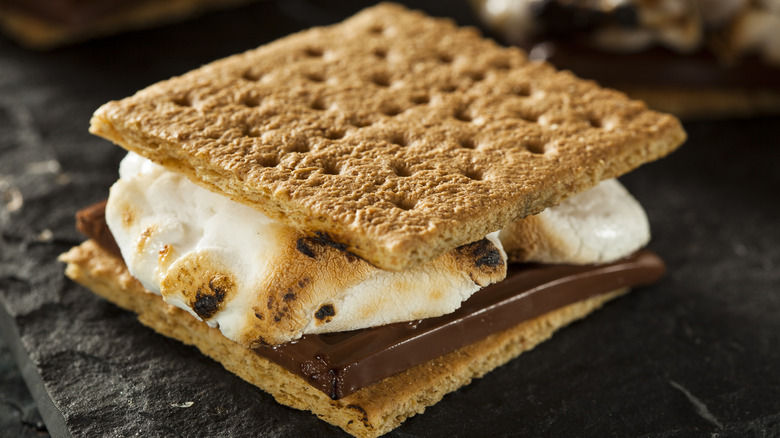We Have Girl Scouts To Thank For The Invention Of S'mores
Who doesn't remember their first s'mores experience? When first encountered, the dance of gooey fire-caramelized marshmallow with creamy milk chocolate and a crunchy graham cracker (literal) crust, can feel as if it were made of magic. If only the history books were clearer as to the identity of the individual who came up with the idea. Then we might be able to thank them, at least in spirit, next time we have the opportunity to indulge.
What is known is that the first published recipe for the fireside delight appeared in a 1927 Girl Scouts publication, "Tramping and Trailing with the Girl Scouts" under the somewhat more formal name, "Some more" (as in "I'll have some more, please!"). In other words, it would appear we have the Girl Scouts of America to thank for both inventing s'mores, as we now know them, and for spreading the word so effectively.
Where things get a bit murky, however, is the question of who, in particular, developed the recipe for the Girl Scouts. Many claim it was a Girl Scout troop leader by the name of Loretta Scott Crew. Certainly, that would track ... or so one might think. There's just one problem.
The Girl Scout troop leader may, herself, have been an invention
The Girl Scouts of America have been making s'mores since at least as far back as 1925. That's when a September 9 story in The Norwalk Hour described a Connecticut Girl Scout troop's camping trip during which the scouts enjoyed a dessert called "Some more."
The publication described the dish as a sandwich consisting of a pair of graham cracker squares stuffed with a toasted marshmallow flanked by two pieces of Hershey chocolate. And it credits Camp Andree Clark (formerly Camp Andree-on-the-Hudson), a Girl Scout camp located in Briarcliff Manner, New York, with "introducing" the treat to the scouts during that trip. But there's no mention of a Loretta Scott Crew — here or anywhere else. Some maintain that's because she never existed.
Some speculate the name was planted on Wikipedia as a hoax, only to be removed when it failed the smell test and subsequent verification. All that's left now are stories by various media outlets that cite one another as evidence of the veracity of this Mobius strip of apocrypha. What we here at Tasting Table have been able to discern, however, is that whoever gave the recipe to the Girl Scouts may have pulled it from a cookbook published by the Campfire marshmallow brand, potentially as early as 1920. Only, in that case, it was referred to as a "Graham Cracker Sandwich." The rest, as they say, is history.

